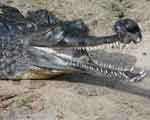New research from the SMU Geothermal Laboratory, funded by a grant from Google.org, documents significant geothermal resources across the United States capable of producing more than three million megawatts of green power – 10 times the installed capacity of coal power plants today.
Sophisticated mapping produced from the research, viewable via Google Earth at http://www.google.org/egs/, demonstrates that vast reserves of this green, renewable source of power generated from the Earth’s heat are realistically accessible using current technology.
The results of the new research, from SMU Hamilton Professor of Geophysics David Blackwell and Geothermal Lab Coordinator Maria Richards, confirm and refine locations for resources capable of supporting large-scale commercial geothermal energy production under a wide range of geologic conditions, including significant areas in the eastern two-thirds of the United States.
Resource estimations based on thousands of data sites
The estimated amounts and locations of heat stored in the Earth’s crust included in this study are based on nearly 35,000 data sites – approximately twice the number used for Blackwell and Richards’ 2004 Geothermal Map of North America, leading to improved detail and contouring at a regional level.
Based on the additional data, primarily drawn from oil and gas drilling, larger local variations can be seen in temperatures at depth, highlighting more detail for potential power sites than was previously evident in the eastern portion of the U.S. For example, eastern West Virginia has been identified as part of a larger Appalachian trend of higher heat flow and temperature.
Conventional U.S. geothermal production has been restricted largely to the western third of the country in geographically unique and tectonically active locations.

For instance, The Geysers Field north of San Francisco is home to more than a dozen large power plants that have been tapping naturally occurring steam reservoirs to produce electricity for more than 40 years.
Many new regions considered capable of geothermal energy production
However, newer technologies and drilling methods can now be used to develop resources in a wider range of geologic conditions, allowing reliable production of clean energy at temperatures as low as 100˚C (212˚F) – and in regions not previously considered suitable for geothermal energy production. Preliminary data released from the SMU study in October 2010 revealed the existence of a geothermal resource under the state of West Virginia equivalent to the state’s existing (primarily coal-based) power supply.
“Once again, SMU continues its pioneering work in demonstrating the tremendous potential of geothermal resources,” said Karl Gawell, executive director of the Geothermal Energy Association. “Both Google and the SMU researchers are fundamentally changing the way we look at how we can use the heat of the Earth to meet our energy needs, and by doing so are making significant contributions to enhancing our national security and environmental quality.”
“This assessment of geothermal potential will only improve with time,” said Blackwell. “Our study assumes that we tap only a small fraction of the available stored heat in the Earth’s crust, and our capabilities to capture that heat are expected to grow substantially as we improve upon the energy conversion and exploitation factors through technological advances and improved techniques.”
Blackwell is scheduled to release a paper with details of the results of the research to the Geothermal Resources Council in October 2011.
SMU map proposes new international standard for estimating geothermal resource
Blackwell and Richards first produced the 2004 Geothermal Map of North America using oil and gas industry data from the central U.S. Blackwell and the 2004 map played a significant role in a 2006 Future of Geothermal Energy study sponsored by the U.S. Department of Energy that concluded geothermal energy had the potential to supply a substantial portion of the future U.S. electricity needs, likely at competitive prices and with minimal environmental impact. SMU’s 2004 map has been the national standard for evaluating heat flow, temperature and thermal conductivity for potential geothermal energy projects.
In this newest SMU estimate of resource potential, researchers used additional temperature data and in-depth geological analysis for the resulting heat flow maps to create the updated temperature-at-depth maps from 3.5 kilometers to 9.5 kilometers (11,500 to 31,000 feet).
This update revealed that some conditions in the eastern two-thirds of the U.S. are actually hotter than some areas in the western portion of the country, an area long-recognized for heat-producing tectonic activity. In determining the potential for geothermal production, the new SMU study considers the practical considerations of drilling, and limits the analysis to the heat available in the top 6.5 km (21,500 ft.) of crust for predicting megawatts of available power.
This approach incorporates a newly proposed international standard for estimating geothermal resource potential that considers added practical limitations of development, such as the inaccessibility of large urban areas and national parks. Known as the “technical potential” value, it assumes producers tap only 14 percent of the “theoretical potential” of stored geothermal heat in the U.S., using currently available technology.
New technology developments have sparked geothermal development
Three recent technological developments already have sparked geothermal development in areas with little or no tectonic activity or volcanism:
1) Low Temperature Hydrothermal – Energy is produced from areas with naturally occurring high fluid volumes at temperatures ranging from less than boiling to 150°C (300°F). This application is currently producing energy in Alaska, Oregon, Idaho and Utah.
2) Geopressure and Coproduced Fluids Geothermal – Oil and/or natural gas are produced together with electricity generated from hot geothermal fluids drawn from the same well. Systems are installed or being installed in Wyoming, North Dakota, Utah, Louisiana, Mississippi and Texas.
3) Enhanced Geothermal Systems (EGS) – Areas with low fluid content, but high temperatures of more than 150°C (300°F), are “enhanced” with injection of fluid and other reservoir engineering techniques. EGS resources are typically deeper than hydrothermal and represent the largest share of total geothermal resources capable of supporting larger capacity power plants.
Goal is to aid evaluation of regional nonconventional geothermal resources
A key goal in the SMU resource assessment was to aid in evaluating these nonconventional geothermal resources on a regional to sub-regional basis.
Areas of particular geothermal interest include the Appalachian trend (Western Pennsylvania, West Virginia, to northern Louisiana), the aquifer heated area of South Dakota, and the areas of radioactive basement granites beneath sediments such as those found in northern Illinois and northern Louisiana. The Gulf Coast continues to be outlined as a huge resource area and a promising sedimentary basin for development. The Raton Basin in southeastern Colorado possesses extremely high temperatures and is being evaluated by the State of Colorado along with an area energy company.
SMU’s Geothermal Laboratory in Dedman College of Humanities and Sciences conducted this research through funding provided by Google.org, which is dedicated to using the power of information and innovation to advance breakthrough technologies in clean energy. — Kimberly Cobb
SMU is a nationally ranked private university in Dallas founded 100 years ago. Today, SMU enrolls nearly 11,000 students who benefit from the academic opportunities and international reach of seven degree-granting schools. For more information see www.smu.edu.
SMU has an uplink facility located on campus for live TV, radio, or online interviews. To speak with an SMU expert or book an SMU guest in the studio, call SMU News & Communications at 214-768-7650.


 To book a live or taped interview with David Blackwell in the SMU
To book a live or taped interview with David Blackwell in the SMU 

 SMU to help solve dangerous refugee water issues
SMU to help solve dangerous refugee water issues




One reply on “SMU Geothermal Lab project: Vast clean energy source confirmed by Google.org-funded geothermal mapping”
[…] > Get the full story from the SMU Research blog […]